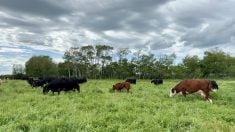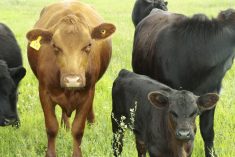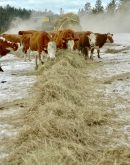Feed supplies are deficient in many areas of the country. Stretching limited forage feed supply while keeping animals healthy, in good condition and maintaining a high level of production and reproduction will be the challenge.
Forages such as hay, greenfeed, silage, straw and forage-seed aftermath are essential in a ruminant ration. Along with providing nutrients, they also contain acid detergent fibre (ADF) and neutral detergent fibre (NDF), keeping the digestive system functioning and healthy. A percentage of the NDF is referred to as effective fibre, which stimulates chewing, saliva production and rumen motility. There are upper and lower limits for fibre requirements in a ration. A high fibre content reduces voluntary feed intake and digestibility. Insufficient fibre reduces the time an animal ruminates (regurgitates and chews) the consumed feed, resulting in lower rumen pH. A faster feed passage rate occurs which also lowers feed digestibility and can cause digestive upsets.
Nutrient requirements differ between animal type and stage of production. Blending different feeds instead of feeding straight hay is an option. Two example rations are in Table 1 (see below).

A rule of thumb for mid-, late- and post-calving rations is to have protein at seven, nine and 11 per cent and a TDN content of 55, 60 and 65 per cent on a dry matter (DM) basis. This is higher than what the Nutrient Requirements of Beef Cattle (NRC 2016) recommends but accounts for winter weather conditions (Agdex 420/52-4).
Read Also

Canadian Beef Check-Off Agency reports on investments and activities
The check-off agency’s work behind the scenes is what ensures cattle check-off dollars are invested wisely, accounted for transparently and deliver measurable value back to producers and importers.
Pre-calving rations don’t need to contain 100 per cent hay, haylage or silage. They can contain up to 40 per cent straw or crop aftermath with minimal amounts of grain. As long as nutrient requirements are met, cow body condition, in-utero calf growth, post-calving milk production and reproductive performance are upheld. Use the hay, haylage or silage in lactating and growing rations because they are of higher quality and suited to meet the nutrient requirements of these animals.
Pre-calving straw-grain rations
Rations formulated using only straw or crop aftermath, grain and a protein source can be fed. Cows can consume 1.1 per cent of body weight in NDF per day (NRC 2016). This equates to a range of 1.25 to 1.5 per cent of dry matter intake of low-quality forage which is 17 to 20 lbs. for a 1,400-pound cow. The amount of grain, protein source and mineral required is higher because straw and aftermath are low-energy, low-protein forages. Calcium and magnesium are generally deficient in these rations, so a high calcium and magnesium mineral is required. A 2:1 mineral generally does not meet requirements.
Limiting forage intake
Limiting high-quality forage intake to one per cent of body weight on a dry basis provides sufficient fibre to keep the rumen functioning. It reduces hay requirements by approximately 14 lbs. per head per day for a 1,400-pound cow. Grain and protein supplementation are higher, replacing nutrients from forage. Cows are not as settled compared to a full hay ration. In feeding trials, no negative impacts were experienced at calving or rebreeding when the ration was properly balanced, and cows maintained body condition over winter.
Using feed additives
Ionophores are proven to reduce dry matter intake and improve feed efficiency by up to 12 per cent by altering rumen function and volatile acid production. Bioactives such as essential oils have more of an effect on the lower digestive system where they improve nutrient use. Prebiotics, probiotics and enzymes also influence efficiency and digestive system health.
Alternate feeds
Drought, hail or an early frost create opportunities to use annual cash crops as cattle feed. Test the feed to reveal potential problems, especially high sulphur or nitrate content.
Byproducts from the ethanol and brewing industry are widely used. Examples of less common feedstuffs available include cull potatoes, overripe fruits from orchards, bakery waste or stale, dated baked products.
Using older hay
Two- or three-year-old hay stored outdoors has a 10 per cent lower digestibility and free choice consumption rate compared to new hay. Bales can be 100 to 200 lbs. lighter compared to when they were made. Retest the hay because quality can change over time.
To develop balanced rations, getting accurate animal weights to estimate feed intake, and the number of bales and weights to calculate available inventories are first steps. Feed testing is next. Use a ration-balancing program to combine different feeds to meet animal requirements and use inventories efficiently.
















